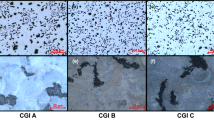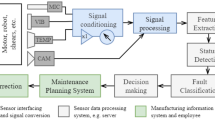Abstract
Detailed knowledge about the relation between wear progression of a cutting tool and the cutting forces generated is of paramount importance for the development of a tool condition monitoring strategy. This paper discusses the changes in the different process signals with progressing tool wear of small diameter twist drills (D=1.5 mm), when drilling boreholes having a depth of 10 times the diameter in plain carbon steel using MQL. The effect of different wear patterns on the process signals is presented. Furthermore, several features, which evolve over the life of the drills, are identified and extracted from the process signals. Knowledge about the evolution of these features can support the user to determine the final tool life stage, so that the drill can be replaced before the final fracture occurs.
Similar content being viewed by others
References
Soederberg S, Vingsbo O, Nissle M (1982) Performance and failure of high speed steel drills related to wear. Wear 75(1):123–143
Koenig W, Kutzner K, Schehl U (1992) Tool monitoring of small drills with acoustic emission. Int J Mach Tools Manuf 32(4):487–493
Nordmann K (2001) Kleinste Werkzeugdurchmesser werden sicher ueberwacht. Maschinenmarkt 1–2:28–29
Nordmann K (2004) Kontrolltechniken sinnvoll kombinieren. Werkstatt und Betrieb 9:18–21
Nordmann K (2003) Fuehlend statt kuehlend. Maschine und Werkzeug 1−2(104):50–51
Rehse M (1999) Flexible Ueberwachung bei der Bohr- und Fraesbearbeitung in einer Autonomen Produktionszelle. Dissertation, Technical University Aachen
Ertunc HM, Loparo KA, Ocak H (2001) Tool wear condition monitoring in drilling operations using hidden markov models. Int J Mach Tools Manuf 41(9):1363–1384
Galloway DF (1956) Some experiments on the influence of various factors on drill performance. Trans ASME 79(2):191–231
Subramanian C, Strafford KN, Wilks PT, Ward LP, McPhee MA (1993) Performance evaluation of TiN-coated twist drills using force measurement and microscopy. Surf Coat Technol 62(1−3):641–648
Nagao T, Hatamura Y, Mitsuishi M (1994) In-process prediction and prevention of the breakage of small diameter drills based on theoretical analysis. Ann CIRP 43(1):85–88
O’Donnell G, Young P, Kelly K, Byrne G (2001) Towards the improvement of tool condition monitoring systems in the manufacturing environment. J Mat Proc Technol 119(1–3):131–139
Kavaratzis Y (1990) Deep hole drilling with twist drills – Aspects of the CNC process and its real time monitoring and adaptive control. Dissertation, University of Aston, Birmingham, UK
United States Cutting Tool Institute (1989) Metal cutting tool handbook. Industrial Press, New York
Weinert K, Adams FJ (1995) Trockenbohren von Stahl mit Cermet, VDI-Z Spezial Werkzeuge 137(2):24–26
Dong WP, Joe Au YE, Mardapittas A (1994) Characteristics of acoustic emission in drilling. Tribology 27(3):169–170
Toenshoff HK, Friemuth T, Mohlfeld A, Podolsky C, Urban B (2001) Influence of soft coatings on chip formation and cutting performance. Proc Materials Week 2001, Munich, pp 1–8
Author information
Authors and Affiliations
Corresponding author
Rights and permissions
About this article
Cite this article
Heinemann, R., Hinduja, S. & Barrow, G. Use of process signals for tool wear progression sensing in drilling small deep holes. Int J Adv Manuf Technol 33, 243–250 (2007). https://doi.org/10.1007/s00170-006-0459-9
Received:
Accepted:
Published:
Issue Date:
DOI: https://doi.org/10.1007/s00170-006-0459-9




